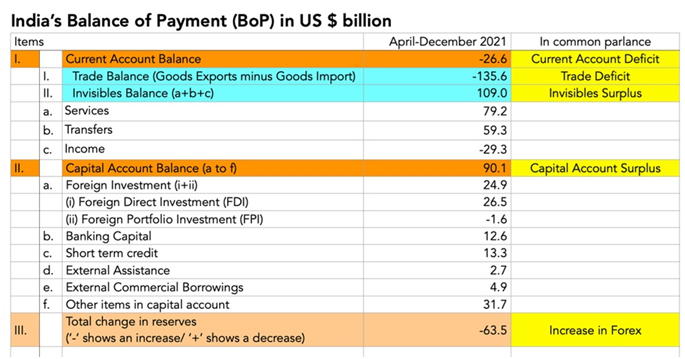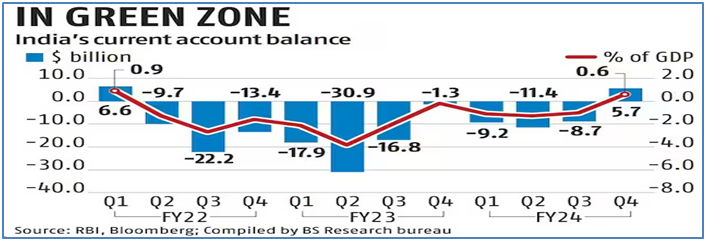Why in News?
After a gap of 10 quarters, India’s current account balance posted a surplus of $ 5.7 billion or 0.6% of gross domestic product (GDP) during the fourth quarter (Jan-Mar) 2024 (Q4FY24) mainly due to a surge in services exports.
The country’s current account cannot be understood in isolation and the larger picture is provided by the so-called ‘Balance of Payments’.
What’s in Today’s Article?
- What is Balance of Payments (BoP)?
- How to Read the RBI’s Q4FY24 BoP Figures?
What is Balance of Payments (BoP)?
- Understanding the meaning of BoP:
- BoP summarises all transactions that a country's individuals, companies, and government bodies complete (over a defined period) with individuals, companies, and government bodies outside the country.
- For example, it shows how much money (in US Dollar or Indian Rupee terms) went out of the country and how much money came into the country.
- These transactions could be -
- Trade (export or import) of goods or services.
- Investments (an Indian buying land in the US or an American firm investing in the Indian stock exchanges).
- Exchange of loans between Indian and other countries of the world, etc.
- Constituents of the BoP:

- All possible transactions are divided into two main accounts - the Current Account and the Capital Account.
- Current Account:
- It refers to all transactions that are related to current consumption and it is further divided into - Trade Balance (the export and import of physical goods) and Invisibles Trade (trade in services, e.g. banking, IT, tourism, etc).
- As can be seen from the table, India had a trade deficit (import>export) but a surplus in the Invisibles trade.
- However, since the trade deficit was bigger than the surplus on the Invisibles trade, the overall current account of India is also in negative or deficit. This is called the Current Account Deficit (CAD).
- Capital Account:
- The capital account refers to those transactions which are not for current consumption, but for investment
- It includes net foreign investments (either foreign direct investment or foreign portfolio investments) and loans or money that countries borrow from each other.
- As can be seen from the table, India had a capital account surplus of $90 billion from April-December 2021 as against a current account deficit of $26.6 billion.
- BOP:
- Individually, either of these accounts can be in surplus or deficit.
- A surplus implies that more money is coming into the country than going out of it. Whereas a deficit (shown with a (-) mark) implies more money is going out of the country than coming in.
- By definition, the BoP always balances, which implies that the deficit on one account must be balanced by a surplus on the other account.
- How does the BoP balance?
- The net result of a current account deficit ($ 26.6 billion) and a capital account surplus ($ 90.1 billion) is that a total of 63.5 billion US dollars have entered the Indian economy.
- To balance the BoP, RBI takes out these dollars and keeps it with itself (shown with a (-) sign before it) and adds (as assets) to its foreign currency reserves.
- The increased forex also leads to an increased money supply in the Indian economy (which can also lead to higher inflation),as RBI increases its liabilities by the same amount ($63.5 billion) by printing the domestic currency.
- This elucidates RBI’s role in maintaining the BoP, which in turn determines India's exchange rate and foreign exchange reserves.
- Why does the RBI intervene? Take a case when more and more dollars have started coming into the Indian economy because of a growing capital account surplus.
- If the RBI does not intervene, the increased demand for rupees vis-a-vis the dollar would have meant that the rupee would have appreciated in value.
- As a result, India’s exports would have become costlier for the US or the rest of the world, thus bringing down their demand.
- At the same time, Indians would have found foreign goods cheaper, thus India’s imports would have gone up.
- This would have led to a widening of the trade deficit or the current account deficit to such an extent that the BoP would have balanced on its own.
- When the RBI intervenes, India's exchange rate remains constant while its forex reserves increase.
How to Read the RBI’s Q4FY24 BoP Figures?

- Apart from a current account surplus of $ 5.7 billion, the Q4FY24 shows a net surplus of $25 billion on the capital account.
- There was a current account deficit of $1.3 billion (0.2% of GDP) during the fourth quarter, which was $8.7 billion (1% of GDP) during the quarter ended December 2023 (Q3FY24).
- Contrary to the images they evoke, the words ‘deficit’ and ‘surplus’ do not always correlate to ‘bad’ and ‘good’ respectively.
- For example, a surplus on the current account in FY 2020-21 does not lead to much economic activities as a result of Covid-induced lockdowns.
- Typically, for a country like India, a current account deficit happens because a developing economy needs to import lots of capital goods (say, machineries) to build up its capacity to produce more exports.
- A trade deficit also suggests that India’s underlying economy has a strong demand impulse.
- For a country like India, a current account deficit of 1.5%-2% of GDP is consistent with a GDP growth rate of 7%-8%.










